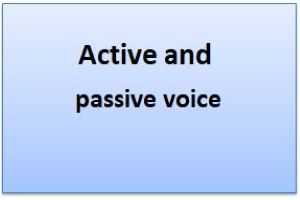Active and passive voice:
Active and passive voice are two different ways of describing how a sentence feels. In the active voice, the subject is performing the action: The dog chases the ball. The passive voice describes the action’s target, the ball, as being positioned first as the focus of the sentence. The sentence gets thrown over, and the subject is now being acted upon by the verb.
The function of Active and Passive Voice in a Sentence:
People use active voice when the sentence contains a verb that describes an action that a person does or is a subject of the sentence. For example: “I play tennis.’ ‘I am playing tennis.’ Active voice is used when there is a corresponding subject in the sentence. Passive voice is used when there is no corresponding subject in the sentence. In sentences that contain an active voice clause, there should be a subject that is doing an action or is the focus of the sentence. Passive voice is used when there is no subject that is performing an action in the sentence. In sentences that contain passive voice, there should be an object that is receiving a feeling or action
How to decide which one to use in a sentence?:
Removing the passive voice should be done with care. The passive voice should not be used to begin a sentence or to avoid responsibility. Neither should it be used to avoid writing or to write shorter. The passive voice should be used in specific instances, such as when writing about things that happen to people or things that are owned by others. Let’s look at a few examples to understand how to use active voice and passive voice in English sentences. Active Voice Passive Voice “The rain is causing flooding.” “The flooding is caused by the rain.” “The cat chased the skateboarder.” “The skateboarder was being chased by the cat.”
Difference between active and passive voice:
Verbs have two voices: active and passive.
Active voice is used when the subject of the sentence performs the action expressed by the verb. For example:
- The watchman opens the door.
In this sentence, the subject (watchman) is performing the action (opens), so we use active voice. Active voice is usually more straightforward and clearer than passive voice.
Passive voice is used when the subject of the sentence receives the action expressed by the verb. For example:
- The door is opened by the watchman.
In this sentence, the subject (door) receives the action (is opened), so we use passive voice.
Active Voice:
The active voice is used when the focus of the sentence is on the subject and the doer of the action is known.
Active Voice Examples:
Sara painted the house.
He helped me.
Passive Voice:
When the emphasis of the sentence is on the activity rather than the subject, the passive voice is used.
Passive Voice Examples:
I was helped by him.
A book is read by Sara.
Helping verb Changes in active vs passive voice:
|
Active voice |
Passive voice |
| Is, am, are | Is being, am being, are being |
| Has, have | Has been, have been |
| Was, were | Was being, were being |
| Will, shall | Will be, shall be |
| Will, have | Will have been |
| Shall have | Shall have been |
| Can | Can be |
| Could | Could be |
| May | May be |
| might | Might be |
| should | Should be |
Pronoun changes in active vs passive voice:
|
Active voice |
Passive voice |
| I | me |
| we | us |
| he | him |
| she | her |
| they | them |
| you | you |
Active and passive voice verbs formation:
| The active voice verb form | The passive voice verb form |
| Has, have | Has been, have been |
| Was, were | Was being, were being |
| had | Had been |
| Will, shall | Will be, shall be |
| Will, have | Will have been |
| can | Can be |
| Could | Could be |
| may | May be |
| might | Might be |
| should | Should be |
In present indefinite sentences change into a passive voice using helping verbs is, are, am, and eliminate “do” or “does”.
In past indefinite sentences change into a passive voice using a helping verb was, were, and eliminate “did”.
While making passive voice sentences below are the changes made in pronouns.
“I” change into “me”
“We” change into “us”
“He” changes into “him”
“She” changes into “Her”
“They” change into “Them”
“You” change into “You”
some times active voice sentences used two objects usually one object is a person and this sentence is called an indirect object, second is usually about a thing, in active voice sentences indirect object is used first, and after that direct object comes. for example.
1) He told me a storyline.
2) I have given him many tickets.
In the above sentences, he is the indirect object, the other side a storyline, and many tickets are direct objects.
However, in, active voice sentences if two objects are available in the conversion of this type of sentence in two objects first object means the indirect object in passive voice sentence used as the subject, above mentioned sentences, changed in passive as:
1) I was told a storyline.
2) He was given many tickets by me.
Note: Basically indirect object is the receiver of the direct object.
Creation of passive voice:
1). Put the object of the passive voice sentence instead of the passive voice subject and please the subject of active voice instead of the passive voice object.
2).change in helping verb as required.
Changing active to passive:

